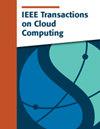Cloud-Edge Collaborative Service Architecture With Large-Tiny Models Based on Deep Reinforcement Learning
IF 5
2区 计算机科学
Q1 COMPUTER SCIENCE, INFORMATION SYSTEMS
引用次数: 0
Abstract
Offshore drilling platforms (ODPs) are critical infrastructure for exploring and developing marine oil and gas resources. As these platforms’ capabilities expand, deploying intelligent surveillance services to ensure safe production has become increasingly important. However, the unique geographical locations and harsh environmental conditions of ODPs pose significant challenges for processing large volumes of video data, complicating the implementation of efficient surveillance systems. This study proposes a Cloud-Edge Large-Tiny Model Collaborative (CELTC) architecture grounded in deep reinforcement learning to optimize the processing and decision-making of surveillance data in offshore drilling platform scenarios. CELTC architecture leverages edge-cloud computing, deploying complex, high-precision large models on cloud servers and lightweight tiny models on edge devices. This dual deployment strategy capitalizes on tiny models’ rapid response and large cloud models’ high-precision capabilities. Additionally, the architecture integrates a deep reinforcement learning algorithm designed to optimize the scheduling and offloading of computational tasks between large and tiny models in the cloud-edge environment. The efficacy of the proposed architecture is validated using real-world surveillance data from ODPs through simulations and comparative experiments.基于深度强化学习的大-小模型云边缘协同服务架构
海洋钻井平台是勘探开发海洋油气资源的重要基础设施。随着这些平台功能的扩展,部署智能监控服务以确保安全生产变得越来越重要。然而,odp独特的地理位置和恶劣的环境条件对处理大量视频数据构成了重大挑战,使高效监控系统的实施复杂化。本研究提出了一种基于深度强化学习的Cloud-Edge Large-Tiny Model Collaborative (CELTC)架构,以优化海上钻井平台场景中监控数据的处理和决策。CELTC架构利用边缘云计算,在云服务器上部署复杂、高精度的大型模型,在边缘设备上部署轻量级的微型模型。这种双重部署策略利用了微型模型的快速响应能力和大型云模型的高精度能力。此外,该架构集成了一种深度强化学习算法,旨在优化云边缘环境中大型和小型模型之间计算任务的调度和卸载。通过模拟和对比实验,利用来自odp的真实世界监控数据验证了所提出架构的有效性。
本文章由计算机程序翻译,如有差异,请以英文原文为准。
求助全文
约1分钟内获得全文
求助全文
来源期刊

IEEE Transactions on Cloud Computing
Computer Science-Software
CiteScore
9.40
自引率
6.20%
发文量
167
期刊介绍:
The IEEE Transactions on Cloud Computing (TCC) is dedicated to the multidisciplinary field of cloud computing. It is committed to the publication of articles that present innovative research ideas, application results, and case studies in cloud computing, focusing on key technical issues related to theory, algorithms, systems, applications, and performance.
 求助内容:
求助内容: 应助结果提醒方式:
应助结果提醒方式:


